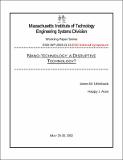| dc.description.abstract | The term "disruptive technology" as coined by Christensen (1997) refers to a new technology having lower cost and performance measured by traditional criteria, but having higher ancillary performance. Christensen finds that disruptive technologies may enter and expand emerging market niches, improving with time and ultimately attacking established products in their traditional markets. This conception, while useful, is also limiting in several important ways.
By emphasizing only "attack from below" Christensen ignores other discontinuous patterns of change which may be of equal or greater importance (Utterback, 1994; Acee, 2001). Further, the true importance of disruptive technology, even in Christensen's conception of it is not that it may displace established products. Rather, it is a powerful means for enlarging and broadening markets and providing new functionality.
In this paper nano-technologies will be considered in their roles as both disruptive and more broadly discontinuous or radical innovation. Various impacts will be assessed with emphasis on enlarged and new markets that may be created. | en_US |
